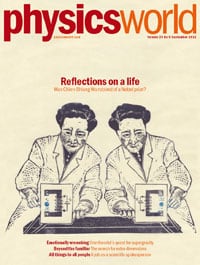By Matin Durrani

Ask a non-scientist what a theoretical physicist does and you’re likely get a shrug of the shoulders along with a guess such as “Scribbles equations all day?” Even most physics students probably don’t know what theorists really do.
In an attempt to shed light on how theoretical physicists work, the September 2012 issue of Physics World, which is now out, contains the first of an occasional series exploring the emotional challenges behind some of the most elegant, ingenious or important calculations in physics
Our plan is to look at calculations that theorists consider their own favourite or that represented a personal triumph – a reward for years of study or a moment of clarity into what science is all about. This month we examine the work of Peter van Nieuwenhuizen, Daniel Freedman and Sergio Ferrara in 1976 on the theory of “supergravity”, which combines supersymmetry with gravity.
Although there is not yet any experimental proof that supergravity is a valid description of the real world, the tale of how the theory was created – as told by science writer David Appell – is fascinating and gripping. You can read Appell’s feature “When supergravity was born” by clicking here.
Elsewhere in the issue, Magdolna Hargittai from Budapest University of Technology and Economics examines the long-standing question of whether the physicist Chien-Shiung Wu should have received a share in the 1957 Nobel Prize for Physics – or whether she missed out to theorists Tsung-Dao Lee and Chen Ning Yang as a result of gender discrimination. Meanwhile, Henrik Melbéus and Tommy Ohlsson from the KTH Royal Institute of Technology in Sweden look into whether CERN’s Large Hadron Collider could find evidence for “extra dimensions”. Plus reviews, careers, lateral thoughts, feedback and much more.
Members of the Institute of Physics (IOP) can access the entire new issue online through the free digital version of the magazine by following this link or by downloading the Physics World app onto your iPhone or iPad or Android device, available from the App Store and Google Play, respectively.
For the record, here’s a rundown of highlights of the issue:
• Support mounts for ‘honeytrap’ physicist – Michael Banks looks at the physics community’s attempts to support 68-year-old particle theorist Paul Frampton, who is languishing in an Argentine jail on drug-smuggling charges
• Delivering on a promise – Shiraz Minwalla says India’s education needs to be reformed before the country can realize its full scientific potential
• Critical point: One amazing moment – Robert P Crease wonders why physicists are not doing more to celebrate the centenary of one of the most important events in science – the discovery that crystals diffract X-rays
• Credit where credit’s due? – Magdolna Hargittai asks if physicist Chien-Shiung Wu should have received a share in the 1957 Nobel Prize for Physics – or whether she missed out to theorists Tsung-Dao Lee and Chen Ning Yang as a result of gender discrimination
• Delving into extra dimensions – Henrik Melbéus and Tommy Ohlsson describe three different theories of extra dimensions – universal, large and warped – and how these unseen dimensions could be observed, if they exist at all
• Crackpots and consequences – Margaret Harris reviews Physics on the Fringe: Smoke Rings, Circlons, and Alternative Theories of Everything by Margaret Wertheim
• Science in a dictatorship – Gordon Fraser reviews The German Physical Society in the Third Reich: Physicists between Autonomy and Accommodation edited by Dieter Hoffmann and Mark Walker
• Speak up – The role of spokespeople on international physics collaborations is important, complex and, as David Wark explains, requires skills that nobody ever taught you during your PhD
• Once a physicist: Ralph Palmer – Meet the 12th Baron Lucas – a Conservative member of the House of Lords
• Fiddling around with physics – In this month’s Lateral Thoughts column, Nicole Yunger Halpern muses on what would happen if great physics-loving musicians were to meet
If you’re not yet a member, you can join the IOP as an imember for just £15, €20 or $25 a year via this link. Being an IOPimember gives you a full year’s access to Physics World both online and through the apps.


